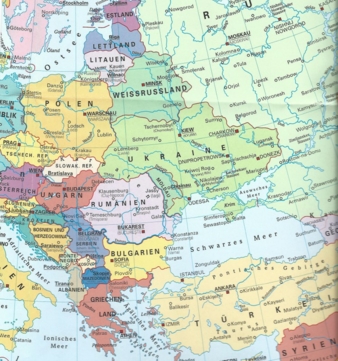27/08/2015 — auf Deutsch lesen
“Go East?”
Rising wage costs and pressure on prices triggered by the liberalisation of global trade are forcing, above all, West European clothing makers to shift production or labour-intensive processes ever farther eastwards. An analysis of the situation from the River Oder to the Urals: Russia
Around 90 percent of the Russian market is controlled by foreign manufacturers. According to estimations released by Moscow-based trade fair organiser Messe Frankfurt little has changed in the past five years; there is similarly little sign of support for the Russian textiles and apparel industry in areas such as modern mechanical engineering, design, favourable lending terms, lower leasing rates and so forth.
Textiles have not been included in the Import Substitution Programmes because business experts do not consider the textiles industry to be of central importance given that the majority of industrialised countries import textile goods: “China sews for the entire globe and Russia isn’t the only country to import clothing from there, with the USA and the EU fostering strong trading links with the Chinese textile industry.” Michail Burmistrov, General Manager of agency “Infoline-analitika”, is of the opinion that: “Labour costs in Russia are high and an obvious obstacle for this industry. Even if the majority of textiles manufacturers are located in regions where wages are low, the production costs in Russia are still too high compared to China, Turkey and even the Ukraine, which greatly diminishes efficiency.”
Official statistics show that Russian trade in textiles with China amounts to USDollar 17bn, with the remainder going to Turkey, Vietnam and others. Russian-made textiles currently account for a 25 percent to 35 percent share of the domestic market. European clothing exports to Russia were on the rise in the five years to 2013, only to fall by around 15 percent since 2014, according to Reinhard E. Döpfer, Chairman of the European Fashion & Textile Export Council, who adds: “We don’t blame the decline in exports on the slide in the rouble and the difficult payment terms caused by the sanctions from the West; we believe it also stems from the impact of structural changes in the Russian retail trade including substantial shifts in the demand for clothing. The Russian market is huge. A new phase of growth has been forecast for 2017 at the latest, which is expected to generate moderate growth rates.”
Modee, based in Germany’s Stollberg, has been exhibiting at the CPM for the past nine years, where it has successfully forged lasting business contacts. However, when the autumn collection was released in 2014, business suddenly crumbled; the rouble, which plummeted in value by more than 100 percent from the spring to the autumn of 2014, and the ailing Russian economy caused buying operations to grind to a halt.
Retail sales in the past 9 to 12 months have proven sluggish at times, resulting in a 50 percent slide in the company’s exports to Russia. Thomas Häusler, CEO, remains optimistic in the face of adversity: “Our preparations for the next CPM are currently under way. Our Russian customers are really important to us and we are helping them out with rouble accounts and discounts.”
The heartland of Russia’s textiles industry in the west, and more specifically in the centres of Ivanovo, Yaroslavl und Kostroma, once peppered with linen/cotton spinning and weaving mills, have had to bid farewell to diversified textile production in the past 20 years. In March 2015, German business magazine Wirtschaftswoche featured a report on the former textiles stronghold Ivanovo, where the last remaining green spinning machines are waiting to be scrapped. These machines are at least 50 years old and in Soviet times helped carve out Ivanovo’s reputation as the Manchester of Russia.
In days gone by, these miracles of engineering were used by the 7,000 or so staff employed by textiles maker Schujskije Sitzy to produce bed linen and tablecloths. The city which is located to the north east of Moscow became the heartland of the textiles industry towards the end of the 18th century: Back then, Tsarina Katharina II. provided tax relief for fabric producers to encourage them to create jobs for poverty stricken peasants. Instead, the city attracted seamstresses from all over the tsardom, turning Ivanovo into the “city of brides” well into the Soviet era.
Today, the Schujskije Sitzy textiles centre is filled with fully automatic high-tech spinning machines that operate around the clock and are produced by global market leader Trützschler, based in Mönchengladbach, Germany. The company would have the potential to come out of the crisis on top, if it were not for several obstacles: the falling value of the rouble is inflating the price of raw materials and spare parts from abroad. Moreover, the sanctions imposed by the West are practically making it impossible to finance new investments.
Wasili Guschtschin, CEO of Ivregion Synthes, steers the fortunes not only of one of the region’s biggest textiles producers, but also one of the few successful exporters which also supplies Ikea. He says that while dyes and chemicals have become more expensive, the dearer cotton imports which he buys in US dollars from Central Asia, partially absorb the currency effects.
Guschtschin can only muster a tired smile of resignation when he hears the political buzzword “Import Substitution”, which is synonymous with Russian defiance towards the sanctions from the West: “The financial system currently isn’t in a position to provide the capital needed for investments at short notice.” Irrespective of whether investments are required in upstream products, production capacities or processes to enhance quality – the lending and capital market is pretty much closed even to the larger manufacturers.
The situation is similar in the field of machine engineering: The sales opportunities for German mechanical engineering companies are continuing to disappear. In the first quarter of 2015, machinery exports to Russia nosedived by a good 28 percent against the same period the year before. Even though demand among Russian customers remains as high as ever, they can effectively order very little. In a variety of sectors, German supplies are, however, indispensable which suggest there may still be opportunities for these companies.
Enterprises wanting to finance the export of plant and machinery to Russia are coming up against the reticence of Western banks in dealings with Russia. Many mechanical engineering firms now fear that they may lose the Russian market to their Chinese competitors. Over the past ten years, Chinese companies have already robbed German mechanical engineering companies of 10 per cent of their market share. This does not mean that the German companies are ready to give up without a fight. On the contrary.
Experts see opportunities for Russian manufacturing in the military field. The production of uniforms and military apparel of all kinds is being subsidised by the state and also supported by the banks. In 2016, there is likely to be a programme for the manufacture and marketing of school uniforms. The BTK Group, one of the largest menswear and uniform producers in Russia, is currently investing more than 30m USDollar in the construction of a company specialising in the production of synthetic fabrics and apparel in Shakhty. The common problem of lacking skilled labour can be solved in this region by Ukrainian refugees.
Forecasts for Russia’s textiles industry predict double-digit increases in demand for synthetic and technical textiles. This stands in direct contrast to the recently imposed ban on importing machinery. Until now, Russia has been largely dependent on imports for its technical equipment, fabrics and also fibres. The market for technical textiles is still very much dominated by foreign companies. Fabrics and fibres come from Asian countries such as China and South Korea as well as Turkey.
According to statistics released by the Ministry of Trade and Industry and analyses by the BTK Group, 82 percent of all synthetic fabrics are imported, compared with 56 percent of nonwovens, 65 percent of polyester fibres and 48 percent of other manmade fibres. The government has set its sights on increasing the share of domestic production in the field of technical textiles to an ambitious 80% by 2020. Hydrocarbons are available in sufficient quantities on the domestic market for the production of man-made fibres.
A model example is Baltex, a leading Russian company specialising in technical textiles and nonwovens, which is investing US$ 200m in expanding its polyamide fibres and fabric production facility over the next few years. Plans are in the pipeline to create a production centre for man-made fibres and technical textiles in Ivanovo. This could breathe new life into a location that has always focused on home textiles and textiles for medical purposes. Similar projects are in the offing in the special economic zone of Alabuga and in Karbadino-Balkaria. CEO Guschtschin has likewise set his sights on building a factory for synthetic textiles, requiring an investment of over 200m Euro.
The aim is to produce, for example, efficient insulation textiles and flame-retardant materials for workers on oil rigs. “Technical textiles offer great potential and will help secure the survival of the traditional home textiles segment,” states the CEO and Vice-President of the Russian Union of Entrepreneurs of Textiles and Light Industry. So far, he has been able to keep all of his 1000 production workers in employment who, he says, would be difficult to replace. He still hopes that the overall situation will ease but has no illusions about the present, concluding: “There won’t be a positive scenario for 2015.”
[Gisela Gozdzik]
[ www.gtai.de]
[ www.vdma.org]
[ www.wiwo.de]
[ www.innovationintextiles.com]
Techtextil Russia 2014 in Moscow ran from 11-13 March.





